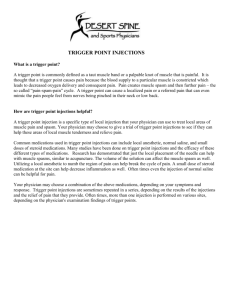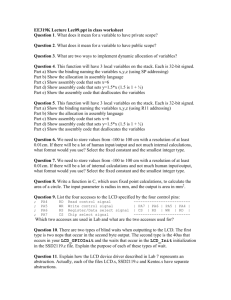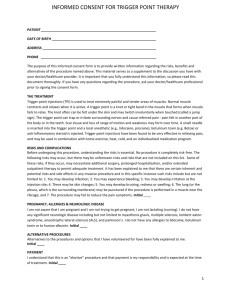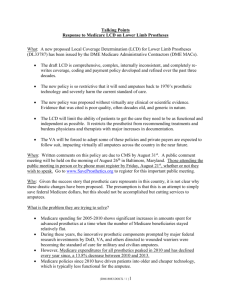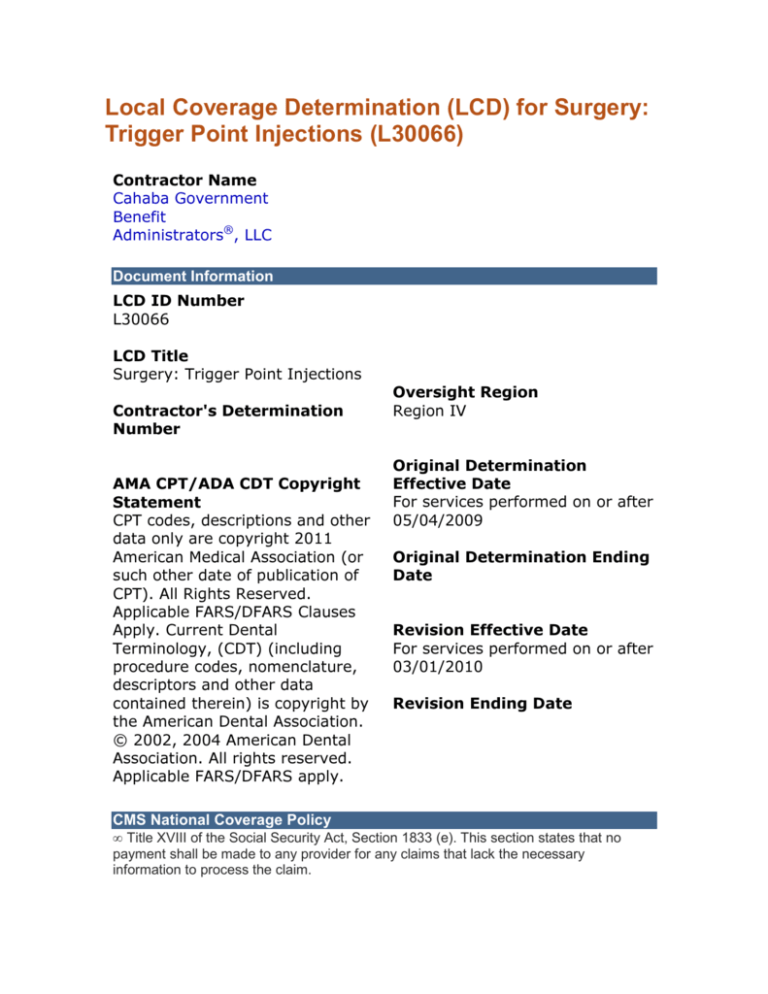
Local Coverage Determination (LCD) for Surgery:
Trigger Point Injections (L30066)
Contractor Information
Contractor Name
Cahaba Government
Benefit
Administrators®, LLC
LCD Information
Document Information
LCD ID Number
L30066
LCD Title
Surgery: Trigger Point Injections
Contractor's Determination
Number
AMA CPT/ADA CDT Copyright
Statement
CPT codes, descriptions and other
data only are copyright 2011
American Medical Association (or
such other date of publication of
CPT). All Rights Reserved.
Applicable FARS/DFARS Clauses
Apply. Current Dental
Terminology, (CDT) (including
procedure codes, nomenclature,
descriptors and other data
contained therein) is copyright by
the American Dental Association.
© 2002, 2004 American Dental
Association. All rights reserved.
Applicable FARS/DFARS apply.
Oversight Region
Region IV
Original Determination
Effective Date
For services performed on or after
05/04/2009
Original Determination Ending
Date
Revision Effective Date
For services performed on or after
03/01/2010
Revision Ending Date
CMS National Coverage Policy
• Title XVIII of the Social Security Act, Section 1833 (e). This section states that no
payment shall be made to any provider for any claims that lack the necessary
information to process the claim.
• Title XVIII of the Social Security Act, Section 1862(a)(1)(A). This section allows
coverage and payment for only those services that are considered to be reasonable and
medically necessary, i.e., reasonable and necessary are those tests used in the
diagnosis and management of illness or injury or to improve the function of a malformed
body part.
• Title XVIII of the Social Security Act, Section 1862(a)(7). This section excludes routine
physical examinations.
• Medicare National Coverage Determinations Manual (Pub. 100-03), Chapter 1,
Section 30.3 addresses acupuncture.
• Medicare National Coverage Determinations Manual (Pub. 100-03), Chapter 1,
Section 150.7 addresses prolotherapy, joint sclerotherapy, and ligamentous injections.
• Medicare Program Integrity Manual (Pub. 100-08), Chapter 13, Local Coverage
Determinations.
Indications and Limitations of Coverage and/or Medical Necessity
Indications
An active trigger point has pain at rest, has pain on palpitation, has radiation of pain, and
has a local twitch response. Trigger point injections are indicated in symptomatic trigger
points. The history of onset of the painful condition and its presumed cause, location,
duration, failed therapies and recommendations for injection therapy of each clearly
delineated muscle must be in the patient’s chart and made available to Medicare upon
request. The goal is to treat the cause of the pain and not just the symptom of pain.
Limitations
1. Trigger point injections accompanied by appropriate adjunctive care should
provide moderate-to-long term benefits. There is no peer-reviewed literature to
substantiate more than four trigger point injections in a year.
2. Acupuncture is not covered by Medicare. If acupuncture is billed using trigger
point therapy codes (20552, 20553) it will be considered not reasonable and
necessary.
3. Prolotherapy is not covered by Medicare. If prolotherapy is billed using trigger
point therapy codes (20552, 20553) it will be considered not reasonable and
necessary.
Coding Information
Bill Type Codes:
Contractors may specify Bill Types to help providers identify those Bill Types typically
used to report this service. Absence of a Bill Type does not guarantee that the policy
does not apply to that Bill Type. Complete absence of all Bill Types indicates that
coverage is not influenced by Bill Type and the policy should be assumed to apply
equally to all claims.
999x Not Applicable
Revenue Codes:
Contractors may specify Revenue Codes to help providers identify those Revenue
Codes typically used to report this service. In most instances Revenue Codes are purely
advisory; unless specified in the policy services reported under other Revenue Codes
are equally subject to this coverage determination. Complete absence of all Revenue
Codes indicates that coverage is not influenced by Revenue Code and the policy should
be assumed to apply equally to all Revenue Codes.
99999 Not Applicable
CPT/HCPCS Codes
20552 Inj trigger point 1/2 muscl
20553 Inject trigger points =/> 3
ICD-9 Codes that Support Medical Necessity
The correct use of an ICD-9-CM code listed in the “ICD-9 Codes that Support Medical
Necessity” section does not guarantee coverage of a service. The service must be
reasonable and necessary in the specific case and must meet the criteria specified in
this LCD.
ICD-9 codes must be coded to the highest level of specificity. Consult the ‘Official ICD-9CM Guidelines for Coding and Reporting’ in the current ICD-9-CM book for correct
coding guidelines. This LCD does not take precedence over the Correct Coding Initiative
(CCI).
The diagnosis of trigger points does not have a specific ICD-9-CM code. In order to
facilitate the providers to accurately pre-code the diagnosis, the following ICD-9-CM
codes are being assigned for trigger points in specific muscle groups:
For the following muscle groups use 720.1:
• Serratus anterior
• Serratus posterior
• Quadratus lumborum
• Longissimus thoracis
• Lower thoracic iliocostalis
• Upper and lower rectus abdominis
• Upper lumbar iliocostalis
• Multi fidus
• External oblique
• McBurney's point
720.1 SPINAL ENTHESOPATHY
For the following muscle groups use 723.9:
• Trapezius (upper & lower)
• Sternocleido-mastoid (cervical & sternal)
• Masseter
•
•
•
•
•
Temporalis
Lateral pterygoid
Splenii
Posterior cervical
Suboccipital
723.9
UNSPECIFIED MUSCULOSKELETAL DISORDERS AND SYMPTOMS
REFERABLE TO NECK
For the following muscle groups use 726.19:
• Scaleni
• Subscapularis
• Levatorscapulae
• Brachialis
• Deltoid (anterior & posterior)
• Middle finger extensor
• Infraspinatus/supraspinatus
• First dorsal interosseous
• Pectoralis (major & minor)
• Supinator
• Latissimus dorsi
• Rhomboid
726.19
OTHER SPECIFIED DISORDERS OF BURSAE AND TENDONS IN
SHOULDER REGION
For the following muscle groups use 726.39:
• Triceps
• Extensor carpi radialis
• Middle finger flexor
726.39 OTHER ENTHESOPATHY OF ELBOW REGION
For the following muscle groups use 726.5:
• Glutei, piriformis
• Adductor longus & brevis
726.5 ENTHESOPATHY OF HIP REGION
For the following muscle groups use 726.71:
• Soleus
• Gastroenemius
726.71 ACHILLES BURSITIS OR TENDINITIS
For the following muscle groups use 726.72:
• Tibialis anterior
726.72 TIBIALIS TENDINITIS
For the following muscle groups use 726.79:
• Peroneus longus & brevis
• Extensor digitorum & hallucis longus
• Third dorsal interosseous
726.79 OTHER ENTHESOPATHY OF ANKLE AND TARSUS
For the following muscle groups use 726.90-726.91:
• Rectus femoris
• Vastus intermedius
• Vastus medialis
• Vastus lateralis (anterior & posterior)
• Biceps femoral
726.90 726.91
ENTHESOPATHY OF UNSPECIFIED SITE - EXOSTOSIS OF
UNSPECIFIED SITE
Diagnoses that Support Medical Necessity
NA
ICD-9 Codes that DO NOT Support Medical Necessity
Any ICD-9-CM code that is not listed in the “ICD-9 Codes that Support Medical
Necessity” section of this LCD.
XX000* Not Applicable
ICD-9 Codes that DO NOT Support Medical Necessity Asterisk Explanation
NA
Diagnoses that DO NOT Support Medical Necessity
Any diagnoses that are not listed in the “ICD-9 Codes that Support Medical Necessity”
section of this LCD.
General Information
Documentations Requirements
1. The patient’s medical record must have:
A. Documentation of the physical findings leading to diagnosis of the
trigger point.
B. The involved muscle group(s) must be documented in the patient’s
medical record as well as the number of trigger points injected. A
diagram with an "X" or other similar annotation is not adequate
documentation.
C. Documentation of the reason(s) for selecting this therapeutic option.
2. Diagnosis codes from the “ICD-9-CM Codes that Support Medical Necessity”
section must be used to support the specific muscles injected. Generalized
diagnoses like low back pain, lumbago, etc. will not be covered.
3. If a patient requires more than four (4) procedures of either CPT codes 20552
or 20553 during one year, a report stating the unusual circumstances and
medical necessity for giving the additional injections must be documented in
the patient's medical record and made available to Medicare upon request.
4. All coverage criteria must be clearly documented in the patient’s medical
record and made available to Medicare upon request.
5. Documentation must support CMS ‘signature requirements’ as described in
the Medicare Program Integrity Manual (Pub. 100-08), Chapter 3.
Appendices
NA
Utilization Guidelines
1. More than four (4) trigger point injections in a year's time will not be covered
by this Contractor.
2. If a patient requires more than four (4) procedures of either CPT codes 20552
or 20553 during one year, a report stating the unusual circumstances and
medical necessity for giving the additional injections must be documented in
the patient's medical record and made available to Medicare upon request.
Sources of Information and Basis for Decision
• Alvarez D.J., Rockwell P.G., University of Michigan Medical School, Ann Arbor,
Michigan; Trigger Points: Diagnosis and Management; Practical Therapeutics, Feb 15,
2002, Volume 65, Number 4, 653-660.
• Borg-Stein, J., MD; Stein, Joel; Trigger Point and Tender Points One and the
Same? Does Injection Treatment Help? Rheumatic Disease Clinics of North America;
Volume 22, Number 2, May 1996, 305–322.
• Ingber, Reuben S., MD; Position Paper on Trigger Point Injections (Fibromyalgia
and Myofascial Pain News); Immunesupport.com; Treatment and Research
Information, 03-28-2003.
• Consultation with Cahaba GBA Part B CMDs from Alabama, Georgia and
Mississippi.
• Consultations with the representatives to the Carrier Advisory Committee.
• Other Medicare Carriers’ LCDs.
Advisory Committee Meeting Notes
Start Date of Comment Period
End Date of Comment Period
Start Date of Notice Period
Revision History Number
#3
Revision History Explanation
Revision 3
Revision Date: October 14, 2011
Effective Date: March 1, 2010
•
•
Template language in the ‘ICD-9 Codes that Support Medical Necessity’
section was added regarding correct coding guidelines.
Added to the Documentation Requirements: Documentation must support
‘signature requirements’ as described in the Medicare Program Integrity
Manual (Pub. 100-08), Chapter 3’. (Change Request 6698)
No change in effective date or coverage.
Revision 2
Start Date of Notice Period: July 14, 2009
Effective Date: August 29, 2009
As part of the J10 MAC transition, LCD effective for contractor number 10302 –
Tennessee Part B.
Revision 1
Start Date of Notice Period: June 17, 2009
Effective Date: August 1, 2009
As part of the J10 MAC transition, LCD effective for contractor number 10202 –
Georgia Part B.
Original
Start Date of Notice Period: March 20, 2009
Effective Date: May 4, 2009
As part of the J10 MAC transition, LCD effective for contractor number 10102 –
Alabama Part B.
11/21/2010 - For the following CPT/HCPCS codes either the short description and/or
the long description was changed. Depending on which description is used in this
LCD, there may not be any change in how the code displays in the document:
20552 descriptor was changed in Group 1
20553 descriptor was changed in Group 1
Reason for Change
Maintenance (annual review with new changes, formatting, etc.)
Narrative Change
Related Documents
This LCD has no Related Documents.
LCD Attachments
There are no attachments for this LCD.
All Versions
Updated on 10/14/2011 with effective dates 03/01/2010 - N/A
Updated on 12/10/2010 with effective dates 08/29/2009 - 02/28/2010
Updated on 11/21/2010 with effective dates 08/29/2009 - N/A
Updated on 12/03/2009 with effective dates 08/29/2009 - N/A
Updated on 06/24/2009 with effective dates 08/29/2009 - N/A
Some older versions have been archived. Please visit the MCD Archive Site to retrieve
them.
Read the LCD Disclaimer

